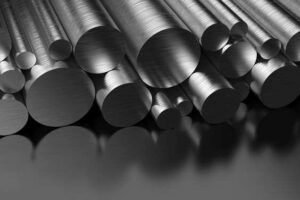Beyond Cutting: Tool Steel’s Role in Forming and Shaping
 Tool steels are synonymous with durable cutting tools and blades. But their unique properties also enable forming and shaping components through rolling, pressing, bending, casting, extruding and more. Through careful hardness and toughness balancing, tool steels construct the dies, molds, rollers, and forming machinery that churn out precision parts essential to modern life.
Tool steels are synonymous with durable cutting tools and blades. But their unique properties also enable forming and shaping components through rolling, pressing, bending, casting, extruding and more. Through careful hardness and toughness balancing, tool steels construct the dies, molds, rollers, and forming machinery that churn out precision parts essential to modern life.
In this article, we’ll go beyond cutting to explore tool steel’s vital role in forming processes. See how tailored strength, fatigue limits, and thermal stability craft sheet metal production lines, plastic injection molds, forging presses, and wire drawing dies that shape raw materials into finished goods. Discover how slight differences in tool steel can mean the distinction between castings that meet demanding tolerances or fail prematurely. In forming, those small margins make an outsized impact.
An Introduction to Forming Tool Steels
Tool steels refer to the family of specialty alloy steels engineered to withstand the extreme pressures, temperatures, friction, and impacts encountered in manufacturing. Key attributes for forming include:
- Hardness to resist deformation under high loads
- Strength and fatigue life to endure millions of cycles
- Fracture toughness preventing cracks under stress
- Resistance to wear, plastic deformation, and heat checking
- Dimensional stability across repeated thermal cycling
- Corrosion resistance in hot, humid forming environments
These properties allow tool steels to be machined into durable dies, molds, rollers, and presses that produce precision formed components consistently in high volumes. When engineered right, tool steel delivers forming accuracy and productivity gains.
Sheet Metal Forming
Producing automobile bodies, aircraft skins, appliances, culverts, and numerous other sheet metal fabrications involves progressive stamping dies made of tool steel. The material’s characteristics enable:
Blank, Pierce, and trim
Accurately cutting sheet into separate parts means overcoming toughness and huge shearing forces. Wear-resistant, impact-proof cold work tool steels like D2 and D3 maintain sharp die edges through millions of parts.
Bend and Shape
Forming sheet into complex 3D shapes via bending and drawing requires tool steels that flex slightly without fracturing. Shock-resistant grades like S7 withstand hundreds of parts per minute year after year.
Hem, Crimp, and Join
Creating leak-proof seams involves high precision mating dies making hundreds of small joints per part. Tough, stable tool steels excel, absorbing forces while retaining edge accuracy.
Thanks to tool steel dies, sheet flows effortlessly from coil to finished part meeting the tightest tolerances at high speeds.
Plastic Molding Production
Injection molds and extrusion dies crafted from tool steels churn out millions of tight-tolerance plastic components:
Injection Molding
Forming tight-tolerance plastic parts like electronics cases, medical components, and automotive interior trim demands polished, corrosion-resistant P20 and 420 steels that hold micro-precision across millions of cycles. Textured surfaces resist abrasive-filled polymers.
Profile Extrusion
Extruding complex polymer profiles like tubes, weatherstripping, and window components requires durable dies made from hot work or maraging tool steels that maintain dimensional accuracy even when exposed to aggressive melt temperatures and pressures.
Blow Molding
Blow molding hollow containers subjects tooling to biaxial stretching stresses. Ductile, fatigue-resistant tool steels retain integrity across thousands of inflation cycles without cracking or degrading. This consistency ensures reliable molding runs.
Tool steel provides mold makers crucial capabilities that plastic engineers rely on to design groundbreaking new polymer components.
Hot Metal Forming and Casting
Shaping red-hot metals through die casting, forging, and molding depends on tool steels engineered to withstand tremendous heat:
Die Casting
Pouring molten aluminum, magnesium, or zinc at high velocity demands tool steel dies that resist erosive wear, thermal fatigue, and creep deformation over hundreds of thousands of shots. H13 excels, containing the pressure and heat while delivering precision castings.
Hot Forging
Massive tool steel dies utilize hardness and fatigue limits to form complex parts like engine crankshafts and suspension components from glowing hot steel slugs. Hundreds of tons of force heat the dies continuously over years of hot pounding service.
Foundry Tooling
Sand casting, permanent mold casting, and investment casting all require durable tool steel cores, mold frames, and foundry equipment able to contain liquid metal temperatures exceeding 2000°F (1100°C). Repeated rapid heating and cooling cycles demand stability.
Thanks to specialized hot work tool steels, parts take shape easily in their molten state, improving quality and reducing machining.
Wire Drawing, Tubing, and Extrusions
Cables, tubes, bars, rods, and profiles all depend on tool steel dies and containers guiding the material flow. Precise dimensional control during forming prevents flaws:
Wire Drawing
Carbide drawing dies rely on tool steel holders and attachments able to withstand the forces needed to pull wire through hundreds of successive smaller openings. Wear resistance prevents diameter deviations.
Tube Drawing
Shaping precise stainless steel or titanium tubing requires concentric, mirror-finish tool steel dies that maintain consistency across thousands of feet pulled through the dies at high speeds. This cold drawing depends on tool steel’s stability.
Extrusion
Forcing billets of aluminum, steel, or plastic through shaped tool steel dies forms complex profiles with interior features not possible through other methods. Abrasion resistance prevents scoring surfaces during continuous production runs.
With tool steel dies, there’s practically no length or shape limit to the wire, bar, tube, rod, rail, or other long product able to be continuously formed.
Key Takeaways on Tool Steels for Forming

Tool steels bring unique advantages across forming:
- Hardness, strength, and shock resistance craft durable stamping dies and presses.
- Mold steel polishability aids precision plastic components.
- Hot strength contains molten metal during casting and forging operations.
- Fatigue and fracture limits draw wire and tube without cracking dies.
- Thermal stability maintains precision dimensions across temperature fluctuations.
- Corrosion resistance protects in hot, humid stamping and molding environments.
Understanding tool steel properties helps engineers select optimum grades or treatments to overcome specific forming challenges. With science guiding material selection, manufacturers gain new shaping capabilities that can transform part production.
FAQ
How do tool steels enable durable sheet metal stamping and forming?
Tool steels offer:
- Hardness to cut tough sheet cleanly without wearing dies prematurely
- Strength to withstand stamping pressures without distorting
- Shock resistance that absorbs punching forces while retaining accuracy
- Toughness that allows some flexing during bending without fracturing
- Thermal stability keeping tolerances precise across production runs
What properties make tool steels ideal for plastic molding?
For injection molds and extrusion dies, tool steels provide:
- Ability to polish and texture complex contours
- Resistance to scratching and chemical attack from filled polymers
- Consistent cooling and dimensional stability shot after shot
- Strength to withstand clamping forces without distortion
- Thermal fatigue life across thousands of cycles
Why are tool steels essential for hot metal forming processes?
Pressed by massive forces at high temperatures, tool steels offer:
- Strength at forging heat to shape tough metals without failing
- Resistance to thermal fatigue cracks across repeated rapid heating/cooling
- Hardness to resist deformation under tremendous pressures
- Chemical stability to avoid reactions with molten metals
- Workability to machine complex die geometries
How do tool steels enable continuous forming of wire, tubing, and extrusions?
During continuous drawing processes, tool steels provide:
- Wear resistance preventing diameter deviations
- Ability to polish mirrors finishes on wire and tubes
- Strength to withstand drawing forces without distorting
- Thermal stability maintaining precision across production runs
- Toughness resisting cracking under tension and bending forces
What factors guide selecting tool steels for forming operations?
Key selection factors include:
- Required hardness at forming temperatures
- Expected pressures, stresses, and impacts
- Level of precision and surface finish needed
- Total production run lengths before replacement
- Operating temperatures during hot forming
- Extent of corrosive conditions present

